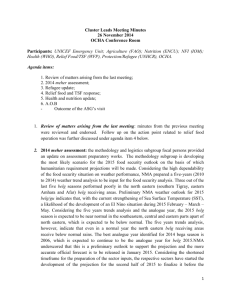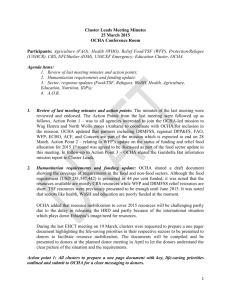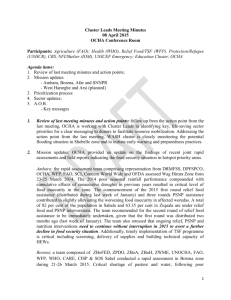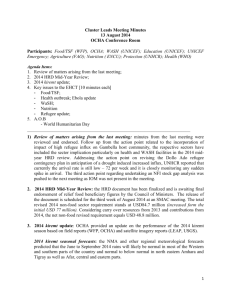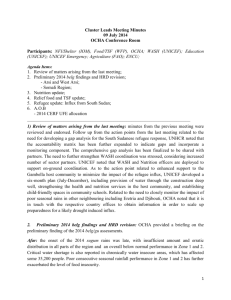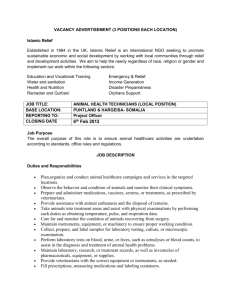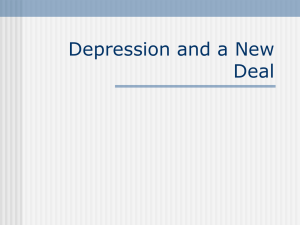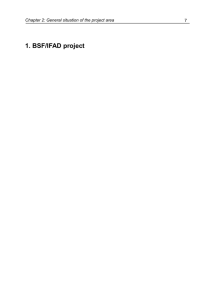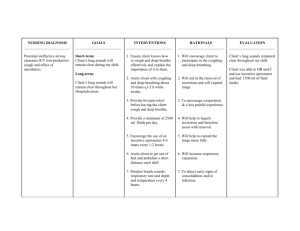Minutes_cluster leads meeting_24 December 2014
advertisement
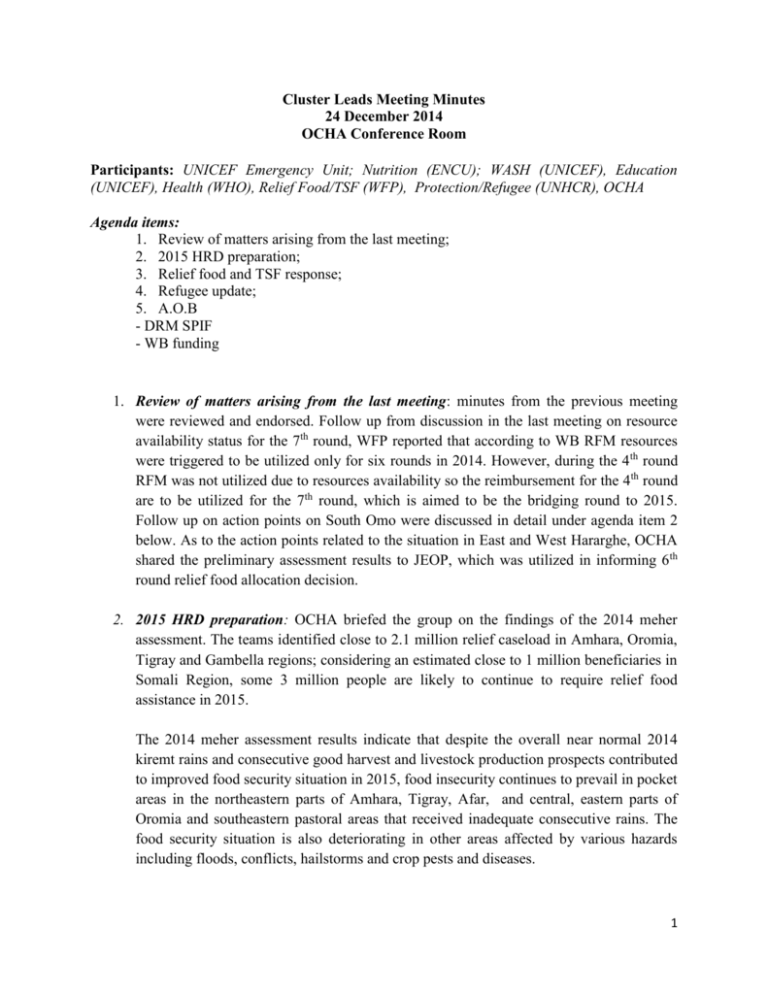
Cluster Leads Meeting Minutes 24 December 2014 OCHA Conference Room Participants: UNICEF Emergency Unit; Nutrition (ENCU); WASH (UNICEF), Education (UNICEF), Health (WHO), Relief Food/TSF (WFP), Protection/Refugee (UNHCR), OCHA Agenda items: 1. Review of matters arising from the last meeting; 2. 2015 HRD preparation; 3. Relief food and TSF response; 4. Refugee update; 5. A.O.B - DRM SPIF - WB funding 1. Review of matters arising from the last meeting: minutes from the previous meeting were reviewed and endorsed. Follow up from discussion in the last meeting on resource availability status for the 7th round, WFP reported that according to WB RFM resources were triggered to be utilized only for six rounds in 2014. However, during the 4th round RFM was not utilized due to resources availability so the reimbursement for the 4th round are to be utilized for the 7th round, which is aimed to be the bridging round to 2015. Follow up on action points on South Omo were discussed in detail under agenda item 2 below. As to the action points related to the situation in East and West Hararghe, OCHA shared the preliminary assessment results to JEOP, which was utilized in informing 6 th round relief food allocation decision. 2. 2015 HRD preparation: OCHA briefed the group on the findings of the 2014 meher assessment. The teams identified close to 2.1 million relief caseload in Amhara, Oromia, Tigray and Gambella regions; considering an estimated close to 1 million beneficiaries in Somali Region, some 3 million people are likely to continue to require relief food assistance in 2015. The 2014 meher assessment results indicate that despite the overall near normal 2014 kiremt rains and consecutive good harvest and livestock production prospects contributed to improved food security situation in 2015, food insecurity continues to prevail in pocket areas in the northeastern parts of Amhara, Tigray, Afar, and central, eastern parts of Oromia and southeastern pastoral areas that received inadequate consecutive rains. The food security situation is also deteriorating in other areas affected by various hazards including floods, conflicts, hailstorms and crop pests and diseases. 1 The onset of the rains was delayed by 2 to 4 weeks in most northeastern meher receiving areas adversely impacting long cycle crops, resulting in below average long cycle crops harvest prospects. Conversely, the extended cessation of the rains contributed in improving the situation particularly the late planted short cycle crops. In these areas below average long cycle crops harvest is expected. In the south and south eastern pastoralist and agro-pastoralist areas, the good deyr rains replenished water sources and pasture. Pocket areas that received inadequate rainfall are experiencing water stress, including Borena zone (Oromia) and Doolo zone (Somali). The situation is of particular concern in South Omo, in SNNPR . A nutrition survey undertaken in September 2014 revealed a critical level of malnutrition with reports of 33.4 per cent GAM in Desenach (South Omo zone) in SNNPR. The 2014 meher assessment team also reported prevalence of adult malnutrition. Dasenech, and Nangatom woredas are crtically affected by flooding and late start of the current meher season. According to the assessment findings, the South Omo zone Agriculture Department estimated that about 50 to 80 per cent loss of maize and sorghum in Dasenech. Similarly, Wheat and barley have also been affected in highland areas. Other source of income like livestock is also affected due to poor availability of pasture in pastoral areas. Pastoral areas have also been affected by poor seasonal performance during the last three consecutive years. The team also identified malaria outbreak to be a critical concern in the area. The 2014 meher assessment team identified a total of 140,479 releif food beneficiaries in the region, of which some 60,000 are in South Omo. IOM reported that some 2,536 kits were sent by the NFI and shelter cluster. UNICEF also reported that ETB 535,000 has been allocated for rehabilitation of damaged water schemes in the area and the operation is to commence soon. Concerns were raised over the inadequate relief food assistance provided to the relief caseload. Although the region requested for relief food assistance for flood affected communities for two months, only 15 days ration assistance was provided in the aftermath of the flooding. Under the TSF blanket distribution programme some 1,465 qt of CSB and 300.9 qt of Oil (a two months ration) transported to Omo Rate town during the third week of December 2014 for targeted 35,698 people (under five children, pregnant and lactating women). Action point: 1) OCHA to follow up with DRMFSS on the provision of relief food assistance to flood affected communities in South Omo; Action point: 2) OCHA to organize a high level joint mission to South Omo to assess the situation, monitor ongoing responses and identify gaps; Action point: 3) UNICEF to check distribution of Mosquito Net in South Omo; 2 Critical level of malnutrition has also been reported in Sehala and Legahida woredas in Nogob zone by the meher assessment team. The deteriorating situation is partly attributed to blockage of food from entering the woredas through the bordering Oromia woredas due to ethnic conflict. The situation is further exacerbated by lack of access to portable water is almost zero percent due to absence of water sources with reliance mainly on seasonal rivers. OCHA urged all sectors to expedite multi-sector response in the two woredas. Recurrent droughts with subsequent rain failures and poor pasture regeneration further increased the communities’ vulnerability to shocks. There are also reports of increased watery diarrhea and dysentery cases during the last hagaa (July-Sept 2014) season and high malaria cases during the recent long rainy season. Action point: 4) Cluster Leads to prioritize Sehala and Legahida woredas woredas in providing an immediate lifesaving intervention. OCHA underscored for the cluster leads to focus on life saving interventions in the 2015 HRD considering the need to prioritize in view of the reduced funding due to competing global priorities. 3. Relief food and TSF response: WFP briefed the group on the dispatch and distribution status for 5th round and the allocation for the 6th round. As of 23 December 2014, the dispatch status for the 5th round stands at 97 per cent with 64 per cent distribution. The prioritization committee met on 22 December 2014 to finalize the allocation for the 6th round. Based on the findings of the 2014 meher assessment and TFP admission reports, East and West Hararghe have been included in the 6th round relief food operation. A total of 3.2 million beneficiaries will be covered during the 6th round. WFP raised concerns that Afdem and Meiso woredas have not received relief food assistance for two rounds due to the Afar and Somali issue. The need to closely monitor and provide assistance in the two woredas was underscored. Action point: 5) the nutrition cluster to assess the situation in Afdem and Meiso woredas considering that relief assistance was not provided for two rounds; Action point: 6) WFP and OCHA to follow up with DRMFSS on the disrupted relief food assistance in Afdem and Meiso; 4. Refugee update: UNHCR and ARRA continue to relocate South Sudanese refugees from Matar way station, Pagak entry point and Pamdong transit site to Pugnido camp. At present, 13,551 new arrivals await relocation to the camp. Meanwhile, on average, 70 refugees are crossing the Ethiopian border every day. The number of daily arrivals is expected to increase with the end of the rainy season. The relocation exercise from Matar, Pagak and Pamdong to Pugnido Refugee Camp continued with support from IOM for transport. A total of 6,507 refugees have been relocated from Matar, including 844 3 unaccompanied and separated children. A new camp site has been identified by the Government in Dembi Dolo (Gambella) to accommodate the continued influx. 5. Sector update: Health: Measles cases continue to be reported in large numbers despite on-going Government efforts for mass immunization. In 2014, more than 15,500 suspected measles cases were reported in 249 woredas nationwide, of which 8,625 confirmed positive. The measles incidence1 rate increased from 3.1 in 2013 to 8.6 in 2014. Due to funding shortfalls, the mass immunization campaigns conducted during the year targeted children under-5. Ideally, the target group should cover all children under-15, since 68 per cent of the cases were between the ages of 5 and 1, and 32 per cent of the reported cases were children under-5. The reported measles vaccination coverage in the country is 71 per cent in 2013 and 60 per cent in 2014. The measles assessment report that identifies the underlying factors for continued high level cases despite the reportedly high level vaccination coverage has not been officially endorsed. Concerns were raised over the little emphasis given to address the recurrent measles outbreak compared to the relatively strong efforts placed to address other communicable disease outbreaks such as meningitis. Action point: 7) UNICEF to follow up on the recurrent measles outbreak in across the country; As to Ebola preparedness, according to the Ebola mission assessment finding, Ethiopia is classified as one of the 14th high risk countries, Addis Ababa being a hub to many international flights and a seat to various Regional and international offices including AU. Shelter: some 9,000 NFI kits are to be procured through the HRF. IOM noted that the distribution focus on targeting rather than blanket distribution. Education: UNICEF signed a programme agreement with three new parnters through which close to 1,600 school age children are benefiting. 4
